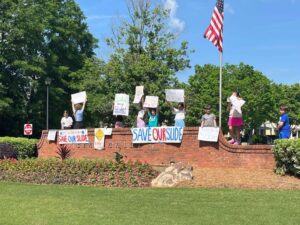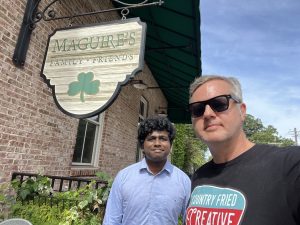After welcoming 2023 and reveling in a Georgia Bulldog victory, I had a moment of reflection and recognized that Peachtree City has gained a lot of new residents over the last decade or so. That being said, many people just do not know the city’s history, the development evolution, and what used to be some remarkably high municipal standards.
Peachtree City might be the only city in Georgia that suffers from founders’ confusion, meaning there are multiple claims to that particular title.
Does alcoholism ignite Peachtree City?
In most of the glossy accounts of Peachtree City’s relatively short history, you will read quite a few distorted, quasi-historical versions of how things began. Here is the real beginning.
The man who bought into a new planned city development concept mimicking the United Kingdom’s “garden cities” movement, a way to capture the primary benefits of the countryside and the city while avoiding the disadvantages presented by both, assembling the investors and the real estate for the creation of Peachtree City, was an alcoholic. The founder of Peachtree City was named Pete Knox, Jr. (1911-1993).
You might ask what does Pete Knox, Jr. being an alcoholic have to do with Peachtree City?
The Knox family out of Thomson, Georgia made their fortune in the timber business and other ventures. Pete Knox, Sr. and his wife died tragically in the Winecoff Hotel fire in Atlanta on December 7, 1946. The tragedy placed the family’s businesses on the shoulders of their son, Pete Knox, Jr.
In post-World War II Georgia, Pete Knox, Jr. began Knox Homes and built new housing developments for the housing boom of the day. He hired landscape architects Willard C. Byrd & Associates to create the layout for those new developments.
Byrd & Associates employee Walter Hunziker, a European familiar with the garden cities movement, was trying to find a developer interested in building a master-planned community. He gave the pitch on the wild idea of forming new towns to Pete Knox, Jr. Knox listened to the presentation, thanked them, and never seemed to show any interest after that.
I had the pleasure of conducting several conversations with Pete Knox, Jr.’s son, Boone Knox (1936-2011), and his father’s battle with alcoholism was noted. As with most, his father’s alcoholism wreaked havoc on the family’s businesses.
Pete Knox, Jr.’s alcohol-fueled impulse business decisions led to Boone and his brother Pete Knox, III (1935-1996) having to spend a significant portion of their young adulthood trying to bail their father out of disaster.
A city from out of nowhere
In an email conversation with Hunziker, he relayed that Pete, Jr. never really appeared interested in their presentation, but months afterward showed up unannounced at the Byrd & Associates office with his arms full of rolled-up land plat maps, 15,000 acres, which he dumped on the conference table. Byrd and Hunziker had no idea what was happening.
Pete, Jr. looked at them and said he secured the land for the new city they were talking about many months ago and they needed to get started. The two landscape architects were stunned because there were no feasibility studies, no preliminary engineering assessments, and no determination on whether the site was even economically viable. (That planning would be conducted years later by Arthur D. Little, lnc. in 1972-04.)
An original newspaper article on the acquisition of the land for Peachtree City is in the collection of Brooks Mayor Dan Langford and on display in Brooks City Hall.
The man dogged by the demons of alcoholism launched an effort to create a brand-new city out of old farmland in a faraway county south of Atlanta with no idea of whether it was even achievable. Alcoholism is associated with greater risk-taking behaviors because alcohol can make people feel less self-conscious or concerned about negative consequences and Pete Knox, Jr. fits the description. The new spontaneous proposal was certainly a risk.
Pete, Jr. wanted his son Pete, III to be the project manager but he was just accepted into the Harvard MBA program. The son recommended his college roommate at Georgia Tech, a young guy named Joel Cowan. Cowan agreed to be the first employee (as Knox’s partner Tom Cousins would say, “their man on the ground.”) and would later become the city’s first mayor.
The next master developer
It would later be determined that the land was not “ripe” for development and there was too much greenspace between Atlanta and Peachtree City, taking decades for the metro population to move southward. Knox and his partners eventually sold the land to Phipps Land Company.
Pete Knox, Jr. ultimately hit bottom with his alcoholism and told his son Boone that he was ready to do something about it. He was accompanied by Boone and Tom Cousins to a treatment facility.
Tom Cousins went on to become a nationally renowned real estate developer and brought professional basketball and hockey to the Atlanta market after building the Omni.
In 1972, Mayor Howard Morgan introduced a “master plan” for the city created by Richard P. Browne Associates featuring multi-use paths. There were less than 400 registered voters in the city at the time.
Eventually, Phipps Land Company could not make a go of it and the Peachtree City development miracle occurred. More on that later.
When you look at the city now, it’s difficult to believe that the whole thing might have begun with a man willing to take significant risks through the filter of alcoholism. And even though Pete Knox, Jr. ultimately sold his interest in the project, it would have never occurred without his impulse real estate purchase, yet he receives very little credit.
In later columns, we can look at the development of a city vastly different from the rest of the metro area and what made it that way.
[Brown is a former mayor of Peachtree City and served two terms on the Fayette County Board of Commissioners]













Leave a Comment
You must be logged in to post a comment.